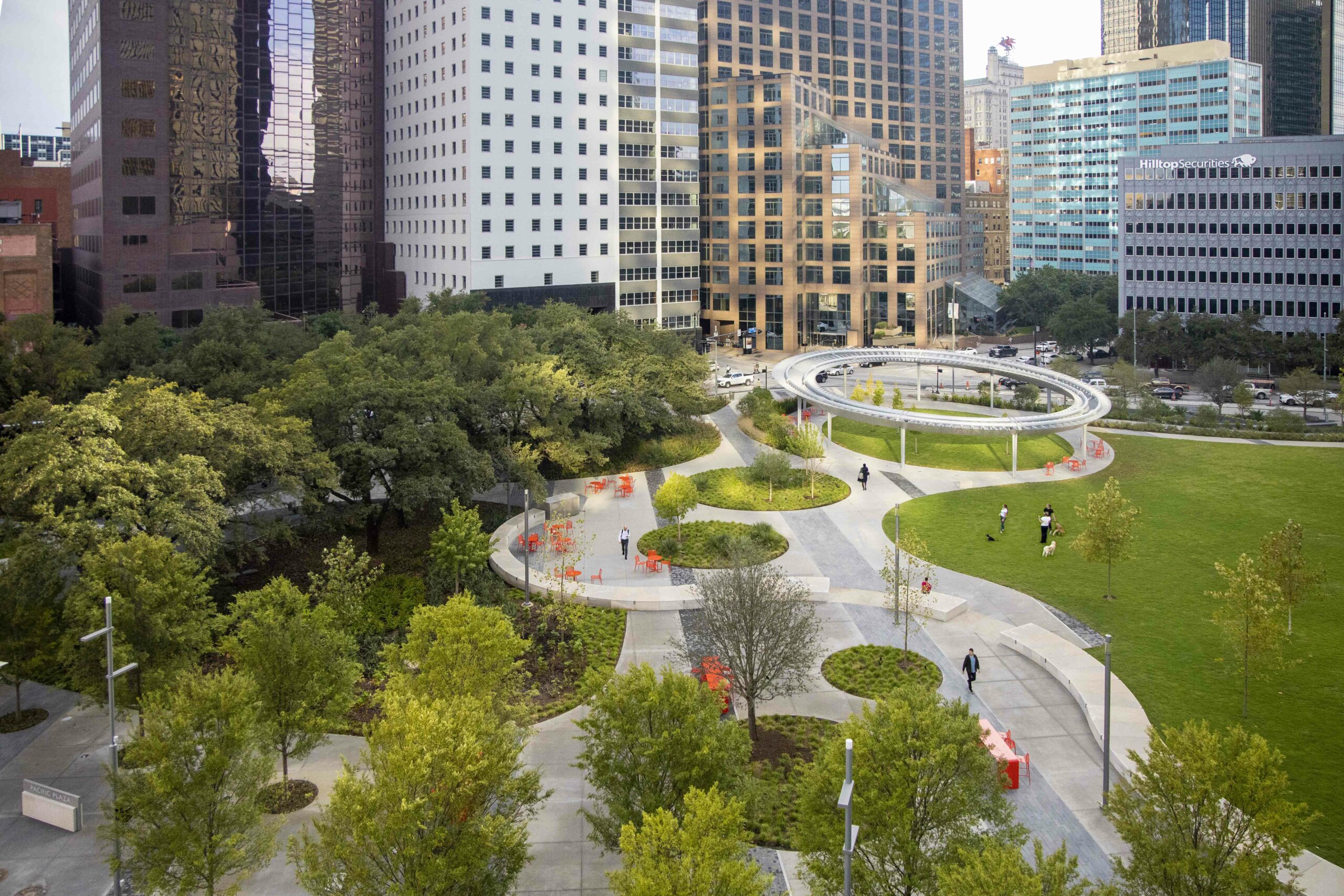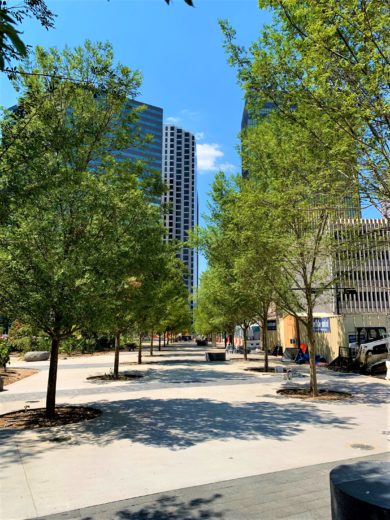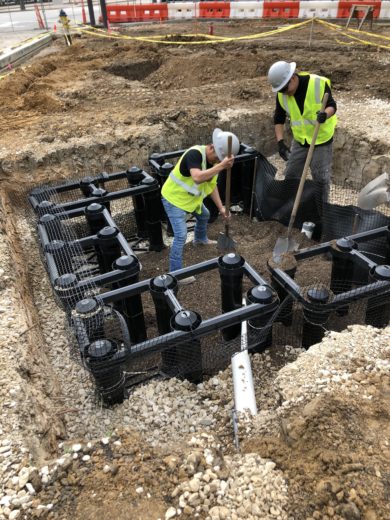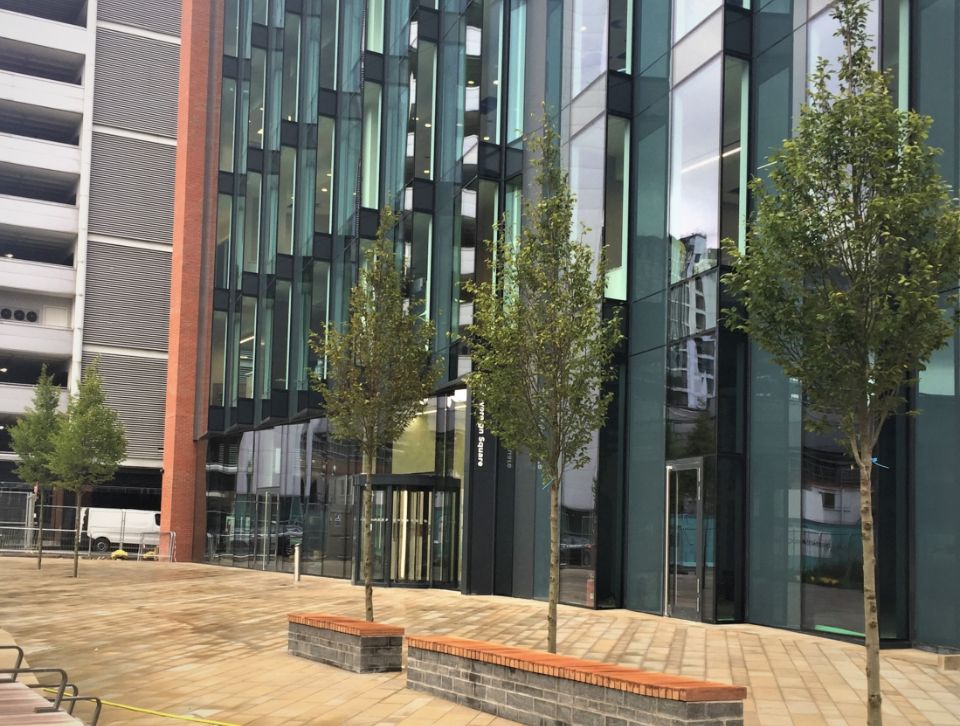The $15 million Pacific Plaza renovation embraced Silva Cells as an alternative to structural soil — and the urban forest is thriving as a refuge during hot Texas days

One of four projects to build inviting, eco-friendly parks in Downtown Dallas, Pacific Plaza transformed in 2018-19 from a concrete parking lot to a 3.7-acre urban green space. The original plan was for the 36 trees to be planted in structural soil; however, the construction team at The Beck Group — having worked with DeepRoot in the past — recommended Silva Cells instead. The result was less site disturbance and a lower cost and soil compaction, resulting in healthier, better-performing trees within an AIA- and ASLA-award-winning urban plaza.

Number of Silva Cells: 180 (2X)
Total Soil Volume: 4,426 ft3 (125 m3 )
Number of Trees and Type: 36
Type of Project: Integrated Trees
Project Designer: SWA Group
Project Contractor: The Beck Group and Nova Landscape Group
Installation Date of Silva Cells: 2018
Project Timeline: 2018-2019

Photo via Bill Tatham from SWA Group
A renovation project funded by Parks for Downtown Dallas, the $15 million Pacific Plaza initiative was one of four such proposed makeovers in the Texas metropolis. The purpose of the project was to convert the gray parking lot into a welcoming urban oasis, a pedestrian-friendly plaza filled with greenery.
Designer at SWA Group knew that trees and other plants help cool the environment, making vegetation a simple and effective way to reduce urban heat islands — a problem in Dallas during the city’s hot summers. Trees and vegetation lower surface and air temperatures by providing shade through evapotranspiration. According to the EPA, shaded surfaces may be 20-45°F (11-25°C) cooler than peak temperatures of unshaded materials. Evapotranspiration, alone or in combination with shading, can help reduce peak summer temperatures by 2-9°F (1-5°C). Trees and vegetation are most useful as a mitigation method when planted in strategic locations around buildings, or to shade pavement in parking lots and on streets.
In the original plans, SWA called for the 36 trees to be planted in a gravel-based structural soil under the pathways leading into the heart of the park, thinking that soil cells were too expensive for the budget. The Beck Group, whose construction division had previously completed successful projects using DeepRoot Silva Cells, recognized the advantages of loam soil for tree growth (as opposed to the rock mix) and proposed substituting the Silva Cells for the structural soil. They also pointed out that the tree would have a soil volume increase for less money because of the 93% or more void space in the cells (versus the 80% rock in the gravel-based structural soil mix).
After DeepRoot’s experienced technical team provided detailed sections and plans as shop drawings to SWA Group, they readily agreed to the change in order to provide the best possible growing environment for the promenade trees, and at a reduced cost to them. Indeed, studies from the Urban Horticultural Institute at Cornell University note that the substitution would be a net increase in soil volume for the trees.

A total of 180 DeepRoot Silva Cells were installed in Pacific Plaza in support of 36 new White Poplar (Poplus Alba) trees. A total of 4,426 cubic feet of shared soil were provided. “At the Beck Group, we understand that by using DeepRoot Silva Cells we can remove a large quantity of structural soil and replace it with a smaller quantity of Silva Cells and achieve the same structural requirements above ground, and have much healthier, better-performing trees,” observed Jim Shipley of The Beck Group.
Likewise, the electrical conduit and drainage pipes were easily accommodated due to the open space within the Silva Cell units and the ability to provide space between the units. The flexibility, modularity, and ease of construction of the Silva Cells were evident throughout the installation — and the excavation and hall-off quantities of soil were significantly reduced by switching from the proposed structural soil solution.
Jim Shipley ultimately praised the Silva Cells for the creation of a flourishing green oasis in Downtown Dallas: “By using DeepRoot Silva Cells at Pacific Plaza, we were able to install a much smaller quantity of material, which meant we had to excavate and haul off less soil. For our customer, Parks for Downtown Dallas, they were able to deliver a green space within walking distance to businesses and downtown residents on budget.”
-2020 AIA Dallas Built Design Award
Photos courtesy of Bill Tatham of SWA Group.
For more details on the architecture and design put into this green infrastructure project, check out this video by Parks for Downtown Dallas:
